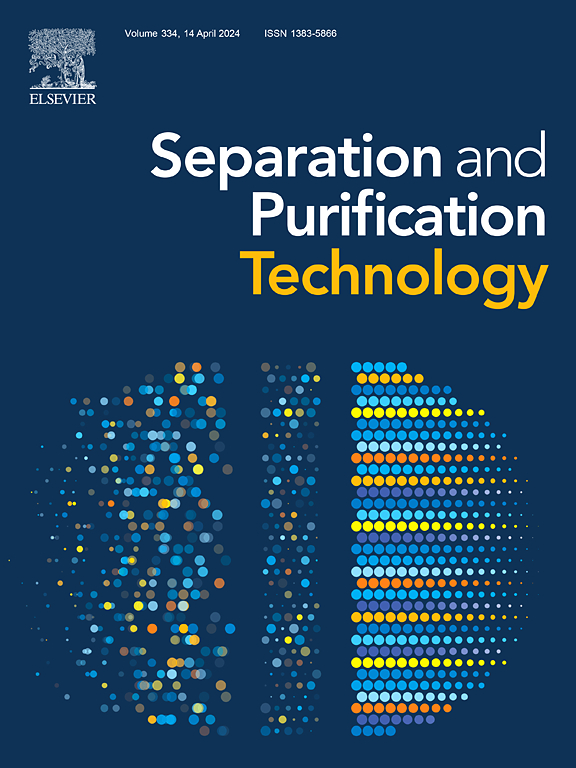Mechanochemistry assisted oxidative desulfurization of high-sulfur petroleum coke over HPMo coupled binary deep eutectic solvent
IF 8.1
1区 工程技术
Q1 ENGINEERING, CHEMICAL
引用次数: 0
Abstract
As the product in the coking of residual oil, the high-sulfur petroleum coke (HSPC, S > 3.0 wt%) has drawn increasing interest for the preparation of graphite electrodes in the steelmaking industry in recent years. How to effectively reduce the sulfide content of HSPC to produce low-sulfur petroleum coke (LSPC, S < 1.0 wt%) with high value is the research hotspot, but remains a huge challenge in the petroleum processing industry. Herein, a novel mechanochemistry-assisted HSPC oxidative desulfurization strategy was proposed with the amide based binary deep eutectic solvent (DES) as the extractant and solvent, and commercial grade phosphomolybdic acid (HPMo) and H2O2 used as catalyst and oxidant, respectively. The novelty of this method lied in the pretreatment of petroleum coke by ball milling, which increased the specific surface area of HSPC, thereby exposing more sulfur sites for the accessibility and reaction with H2O2 and reactive sites, and thereafter significantly enhancing the desulfurization rate of HSPC. The sulfur content of HSPC can be remarkably decreased from 4.46 wt% to 0.51 wt% under the reaction temperature of 60 °C due to the coupling effect between HPMo and DES, which represents the record-high desulfurization rate (88.6 %) and is strikingly higher that the state-of-the-art catalysts reported under the similar conditions so far. This work proposes a new avenue for design and preparation of advanced desulfurization catalyst for petroleum coke in the future.

高硫石油焦在 HPMo 耦合二元深共晶溶剂上的机械化学辅助氧化脱硫过程
作为渣油焦化的产物,高硫石油焦(HSPC,S > 3.0 wt%)近年来在炼钢行业制备石墨电极中越来越受到关注。如何有效降低 HSPC 中的硫化物含量,生产出高附加值的低硫石油焦(LSPC, S < 1.0 wt%)是研究的热点,但在石油加工行业仍是一个巨大的挑战。本文提出了一种新型机械化学辅助 HSPC 氧化脱硫策略,以酰胺基二元深共晶溶剂(DES)为萃取剂和溶剂,以商业级磷钼酸(HPMo)和 H2O2 分别为催化剂和氧化剂。该方法的新颖之处在于通过球磨对石油焦进行预处理,增加了 HSPC 的比表面积,从而暴露出更多的硫位点,以便与 H2O2 和反应位点进行接触和反应,从而显著提高了 HSPC 的脱硫率。由于 HPMo 与 DES 之间的耦合效应,在 60 °C 的反应温度下,HSPC 的硫含量可从 4.46 wt% 显著降至 0.51 wt%,脱硫率(88.6%)创历史新高,大大高于迄今为止在类似条件下报道的最先进催化剂。这项工作为今后设计和制备先进的石油焦脱硫催化剂开辟了一条新途径。
本文章由计算机程序翻译,如有差异,请以英文原文为准。
求助全文
约1分钟内获得全文
求助全文
来源期刊

Separation and Purification Technology
工程技术-工程:化工
CiteScore
14.00
自引率
12.80%
发文量
2347
审稿时长
43 days
期刊介绍:
Separation and Purification Technology is a premier journal committed to sharing innovative methods for separation and purification in chemical and environmental engineering, encompassing both homogeneous solutions and heterogeneous mixtures. Our scope includes the separation and/or purification of liquids, vapors, and gases, as well as carbon capture and separation techniques. However, it's important to note that methods solely intended for analytical purposes are not within the scope of the journal. Additionally, disciplines such as soil science, polymer science, and metallurgy fall outside the purview of Separation and Purification Technology. Join us in advancing the field of separation and purification methods for sustainable solutions in chemical and environmental engineering.
 求助内容:
求助内容: 应助结果提醒方式:
应助结果提醒方式:


